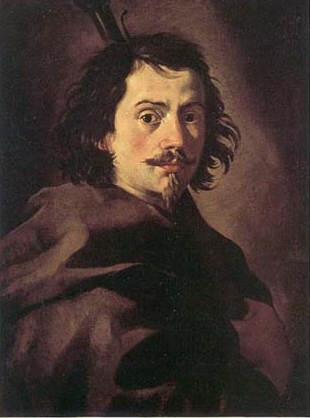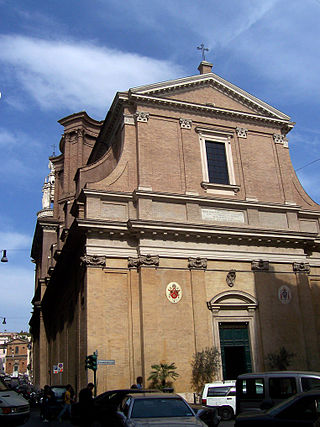
Francesco Borromini, byname of Francesco Castelli, was an Italian architect born in the modern Swiss canton of Ticino who, with his contemporaries Gian Lorenzo Bernini and Pietro da Cortona, was a leading figure in the emergence of Roman Baroque architecture.

Baroque architecture is a highly decorative and theatrical style which appeared in Italy in the early 17th century and gradually spread across Europe. It was originally introduced by the Catholic Church, particularly by the Jesuits, as a means to combat the Reformation and the Protestant church with a new architecture that inspired surprise and awe. It reached its peak in the High Baroque (1625–1675), when it was used in churches and palaces in Italy, Spain, Portugal, France, Bavaria and Austria. In the Late Baroque period (1675–1750), it reached as far as Russia, the Ottoman Empire and the Spanish and Portuguese colonies in Latin America. In about 1730, an even more elaborately decorative variant called Rococo appeared and flourished in Central Europe.

Daniello Bartoli, SJ was an Italian Jesuit writer and historiographer, celebrated by the poet Giacomo Leopardi as the "Dante of Italian prose"

Santa Maria sopra Minerva is one of the major churches of the Order of Preachers in Rome, Italy. The church's name derives from the fact that the first Christian church structure on the site was built directly over the ruins or foundations of a temple dedicated to the Egyptian goddess Isis, which had been erroneously ascribed to the Greco-Roman goddess Minerva.

The Church of the Gesù is the mother church of the Society of Jesus (Jesuits), a Catholic religious order. Officially named Chiesa del Santissimo Nome di Gesù all'Argentina, its façade is "the first truly baroque façade", introducing the baroque style into architecture. The church served as a model for innumerable Jesuit churches all over the world, especially in the Americas. Its paintings in the nave, crossing, and side chapels became models for Jesuit churches throughout Italy and Europe, as well as those of other orders. The Church of the Gesù is located in the Piazza del Gesù in Rome.

Cosimo Fanzago was an Italian architect and sculptor, generally considered the greatest such artist of the Baroque period in Naples, Italy.

Vincenzo Carafa was an Italian Jesuit priest and spiritual writer, elected the seventh Superior-General of the Society of Jesus.

Sant'Andrea delle Fratte is a 17th-century basilica church in Rome, Italy, dedicated to St. Andrew. The Cardinal Priest of the Titulus S. Andreae Apostoli de Hortis is Ennio Antonelli.

Gesù Nuovo is the name of a church and a square in Naples, Italy. They are located just outside the western boundary of the historic center of the city. To the southeast of the spire, one can see a block away the Fountain of Monteoliveto and the piazza of the church of Sant'Anna dei Lombardi. The square is a result of the expansion of the city to the west beginning in the early 16th century under the rule of Spanish viceroy Pedro Alvarez de Toledo. The square of Gesù Nuovo contains three prominent landmarks:

Fra Gregorio Carafa was a nobleman from the House of Carafa and the 61st Grand Master of the Order of Saint John, from 1680 to his death in 1690.

The Church and Convent of the Girolamini or Gerolamini is a church and ecclesiastical complex in Naples, Italy. It is located directly across from the Cathedral of Naples on via Duomo. The facade is across the homonymous piazza and street from Santa Maria della Colonna. It is one block west of Via Duomo.

Sant'Anna dei Lombardi,, and also known as Santa Maria di Monte Oliveto, is an ancient church and convent located in piazza Monteoliveto in central Naples, Italy. Across Monteoliveto street from the Fountain in the square is the Renaissance palace of Orsini di Gravina.

San Gennaro dei Poveri is a former monastery and church complex, later converted into a hospital for indigent located on Via San Gennaro dei Poveri #25 in the Rione Sanità, of the city of Naples, Italy. The elongated complex rises towards Capodimonte, lying just south of the domed Basilica dell'Incoronata Madre del Buon Consiglio.

Sant'Onofrio al Gianicolo is a titular church in Trastevere, Rome. It is the official church of the papal order of knighthood Order of the Holy Sepulchre. A side chapel is dedicated to the Order and a former grand master, Nicola Canali is entombed there. It is located on the Janiculum. Since 1946, the church has been under the care of the American congregation of the Franciscan Friars of the Atonement.

Cesare Dandini was an Italian painter of the Baroque period, active mainly in his native city of Florence.

The Church of St Job is a 15th-century Roman Catholic church located overlooking the campo of the same name, known as Sant'Agiopo in Venetian dialect, on the south bank of the Cannaregio canal near Ponte dei Tre Archi in the sestiere of Cannaregio of Venice, northern Italy,

Santa Maria della Sapienza is a Roman Catholic church, located on Via Costantinopoli in central Naples, Italy.

The church of Santi Severino e Sossio and the annexed monastery are located on via Bartolommeo Capasso in Naples, Italy.

Angelo Italia was an Italian Jesuit and Baroque architect, who was born in Licata and died in Palermo. He designed a number of churches in Sicily, and later worked to reconstruct three cities following the 1693 Sicily earthquake.

The Hospital of the Holy Spirit is the oldest hospital in Europe, located in Rome, Italy. It now serves as a convention center. The complex lies in rione Borgo, east of Vatican City and next to the modern Ospedale di Santo Spirito. The hospital was established on the site of the former Schola Saxonum, a part of the complex houses of the Museo Storico.



















